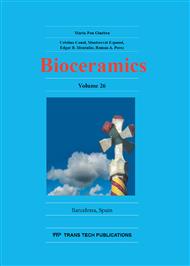p.241
p.247
p.253
p.258
p.262
p.269
p.275
p.283
p.289
A Novel Treatment for Dentine Cavities with Intraoral Laser Ablation Method Using an Er:YAG Laser
Abstract:
Once tooth decay reaches to the inside of dentin, the damage remains permanently. Therefore, the restoration of dentin is important in dental treatment. In the present study, we newly proposed a tooth restoration technique with intraoral laser ablation method. A thin layer of a-tricalcium phosphate (a-TCP) was deposited on dentin surface in the atmosphere by ablation phenomenon using an Er:YAG (Erbium: Yttrium-Aluminium-Garnet) laser irradiated to the target of a-TCP. Then, the deposited layer was hydrolyzed by dripping pure water on its surface in order to create hydroxyapatite (HAp) coating. Interface structure between the HAp coating and dentin surface was observed by a scanning electron microscope. Electron micrographs showed that the HAp layer of 10-20 mm in thickness was formed on the dentin surface. Moreover, dentinal tubules were sealed with the HAp particles. These results indicate that our newly proposed technique is useful for the treatment of dentin cavities.
Info:
Periodical:
Pages:
262-266
Citation:
Online since:
November 2014
Price:
Сopyright:
© 2015 Trans Tech Publications Ltd. All Rights Reserved
Share:
Citation:


